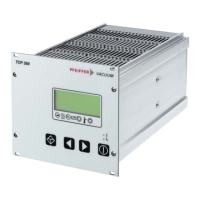7.7 Operating modes
7.7.1 Remote control
Possibilities
●
Operation via the TCP 350 keyboard without explicit prioritization of the operating interfaces
(standard)
●
Remote control via the RS-485 interface
●
Control via the switching functions of the "REMOTE" connection
─
Possible to connect several TCPs
Setting standard operation
►
Set the parameter [P:028] to the value "0".
–
Exception: Pin 14 of "REMOTE" connected with +24 V DC (active high)
Activating "REMOTE" priority
The "REMOTE" connection has priority over all functions of the remaining interfaces.
1. Set the parameter [P:028] to the value "1".
2. Pin 14 of "REMOTE" = active high
–
Exception: Error acknowledgment is still possible via the corresponding key
Deactivating "REMOTE" priority
The "REMOTE" connection has no priority over all functions of the remaining interfaces.
1. Set the parameter [P:028] to the value "1".
2. Pin 14 of "REMOTE" = active low
–
Exception: Error acknowledgment is not possible via pin 13 as long as pin 14 is set to "active
high" again.
7.7.2 Gas type-dependent operation
NOTICE
Turbopump destruction due to gases with too high molecular masses
The pumping of gases with impermissible high molecular masses leads to the destruction of the tur-
bopump.
►
Make sure that the gas mode is set correctly by [P:027] in the electronic drive unit.
►
Consult Pfeiffer Vacuum before you use gases with higher molecular masses (> 80).
High gas throughput and high rotation speed lead to strong friction heating of the rotor. To avoid over-
heating, power-rotation speed-characteristics are implemented in the electronic drive unit. The power
characteristic permits the operation of the turbopump at any rotation speed with the maximum permissi-
ble gas throughput without thermally overloading the turbopump. The maximum power consumption de-
pends on the gas type. Two characteristics are available for the parameterization in order to completely
exhaust the pump's capacity for each gas type.
Operation
39/56

